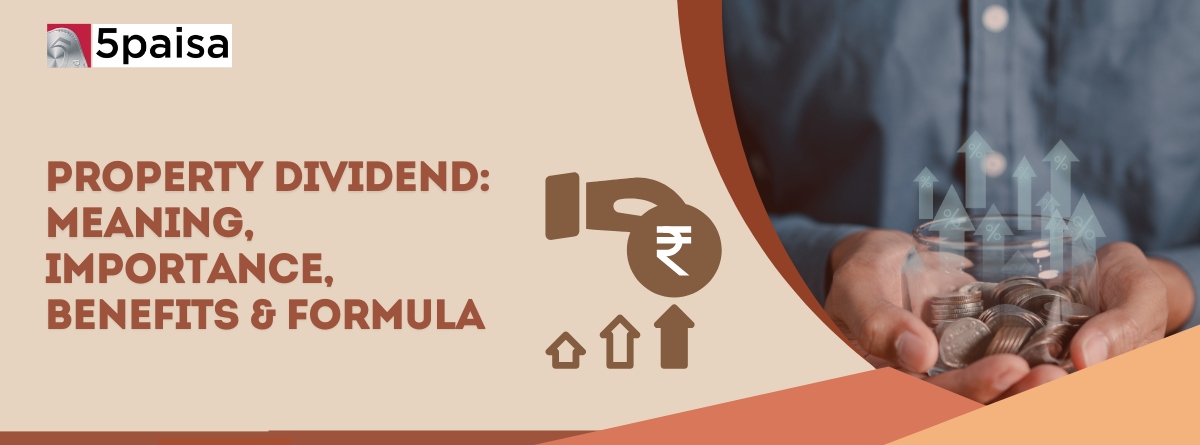Content
In the intricate world of finance, dividends play a pivotal role in connecting investors to the profits generated by the companies they hold shares in. Among the various types of dividends, a lesser-known yet intriguing one is the property dividend. This blog delves into property dividend meaning, exploring their definition, mechanics, formulas, comparisons with other dividend types, significance, benefits, limitations, and more.
Unlock the full article - sign in with Gmail!
Expand Your Market Knowledge with 5paisa Articles
What is a Property Dividend?
A property dividend, also known as an in-kind dividend, is a unique form of distribution that companies occasionally use to reward their shareholders. Unlike traditional dividends, which are paid out in cash, property dividends involve distributing the company's tangible assets to its shareholders.
These assets include real estate properties, machinery, equipment, inventory, or subsidiary company shares. Property dividends enable companies to transfer a portion of their non-cash resources directly to their shareholders.
How a Property Dividend Works
The mechanism behind a property dividend involves a series of steps. First, the company's board of directors determines the distribution of assets and their corresponding market values. Subsequently, these assets are transferred from the company's balance sheet to its dividend account. This transfer is made at fair market value, ensuring a transparent and equitable distribution process.
Property Dividend Formula
Calculating a property dividend involves valuing the assets to be distributed accurately. The formula generally includes the property's market value, the number of shares each investor holds, and any potential liabilities attached to the property. This ensures that the distribution is fair and proportional to the shareholder's ownership.
Property Dividend Example
Let's consider a hypothetical example. A manufacturing company, XYZ Corporation issues a property dividend to its shareholders. The company owns an unused warehouse with a market value of $1 million. If shareholders hold 1,000 shares, they would receive a property dividend of $1,000 worth of warehouse space.
How do Companies Issue Property Dividends?
Companies issue property dividends through a formal process that involves obtaining approval from their board of directors and sometimes from shareholders. Professionals appraise the assets to be distributed to accurately determine their current market value. This evaluation ensures that shareholders receive a dividend that reflects the true value of the company's assets.
Property Dividend Vs Cash Dividend
The primary distinction between property dividends and cash dividends lies in distribution. Cash dividends provide immediate liquidity to shareholders, while property dividends give them ownership of tangible assets. Cash dividends are more common and preferred when companies aim to distribute profits regularly. In contrast, property dividends are seen as a strategic move to optimize the utilization of non-liquid resources.
Property Dividend vs. Bonus Dividend
Bonus or stock dividends involve distributing additional shares to existing shareholders instead of cash. While both property and bonus dividends involve non-cash distributions, bonus dividends increase the number of shares held by each shareholder, while property dividends transfer ownership of tangible assets.
Importance of Property Dividend
Property dividends hold several key advantages. They enable companies to efficiently use surplus assets that might not contribute to their core operations. Additionally, they can enhance shareholder loyalty by directly owning the company's physical resources. This can also lead to potential tax benefits for both the company and its shareholders.
Benefits of Property Dividends
● Asset Utilization: Property dividends help optimize the utilization of underutilized assets, potentially generating previously dormant value.
● Diversification: Shareholders can diversify their investment portfolio by acquiring ownership in different types of assets through property dividends.
● Tax Efficiency: Depending on the jurisdiction, property dividends may offer tax advantages for both the company and shareholders compared to cash dividends.
● Long-Term Value: Property dividends promote a long-term perspective among shareholders, aligning their interests with the company's overall success.
Limitations of Property Dividend
● Liquidity Concerns: Shareholders might prefer cash dividends for immediate liquidity, especially if they want to reinvest in other opportunities.
● Valuation Challenges: Accurately valuing non-cash assets can be complex and may raise disputes regarding fair market value.
● Logistical Hassles: Distributing physical assets requires logistical arrangements, potentially leading to administrative complexities.
Conclusion
In the spectrum of dividend distribution strategies, property dividends stand out as a distinctive approach that bridges the gap between company assets and shareholder rewards. By offering shareholders direct ownership in real assets, companies can optimize their resource allocation while building stronger relationships with their investors.
Although property dividends are less common than cash dividends, they showcase the financial creativity and versatility that modern companies can employ to maximize shareholder value.



